|
|
Creator | Title | Description | Subject | Date |
| 76 |
 |
Harpending, Henry C. | Paternal age and genetic load | The incidence of base substitutions in humans increases with the age of the father, which shows up as an increased incidence of mutational disorders in the children of older fathers. There is a less obvious implication: an extended period of high average paternal age in a population will lead to inc... | | 2013-01-01 |
| 77 |
 |
O'Rourke, Dennis H. | Patterns of genetic variation in native America | Allele frequencies from seven polymorphic red cell antigen loci (ABO, Rh, MN, S, P, Duffy, and Diego) were examined in 144 Native American populations. Mean genetic distances (Nei's D) and the fixation index FST are approximately equal for the North and South American samples but are reduced in the... | Gene frequencies; Amerinds; Genetic Distance | 1992 |
| 78 |
 |
Rogers, Alan R. | Pleistocene population X-plosion? | In two recent papers, Kaessmann et al. presented DNA sequence data from the X chromosome (Xq13.3) of 30 chimpanzees and 69 humans (Kaessmann et al. 1999a; Kaessmann et al. 1999b). These data bear on two longstanding questions involving late Pleistocene demographic history: (1) whether the long-term... | | 2000 |
| 79 |
 |
Rogers, Alan R. | Population differences in quantitative characters as opposed to gene frequencies | Hypotheses about evolution can be tested by comparing genetics differences with those of quantitative characters. Such comparisons are one source of information concerning the forces that maintain variation among natural populations. | Genes; Evolution; Anthropology | 1986-05 |
| 80 |
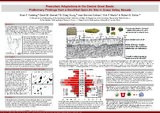 |
Codding, Brian F. | Prearchaic Adaptations in the Central Great Basin: Preliminary findings from a stratified open-air site in Grass Valley, Nevada | Early Holocene occupants of the Great Basin preferentially occupied highly productive habitats surrounding pluvial lakes. While growing evidence details in the adaptations of these Prearchaic foragers in the Eastern (e.g., Madsen et al. 2015) and Western Great Basin (e.g., Jenkins et al. 2012), our... | Anthropology, Cultural - methods - United States; Anthropology, Cultural - methods - Great Basin; Anthropology - Grass Valley, Nevada | 2016 |
| 81 |
 |
Vernon, Kenneth B. | Prearchaic land use in Grass Valley, Nevada: A novel statistical implementation of optimal distribution modeling | Using Prearchaic (PA) sites in Grass Valley, NV (Fig. 1), this project investigates (i) environmental factors driving variation in PA settlement and (ii) geomorphological factors driving variation in PA surface visibility. Building on previous research [1,2], we evaluate variables using Ideal Free D... | Prearchaic - Great Basin; Ideal Free Distribution; Maximum Entropy | 2018 |
| 82 |
 |
Broughton, John | Prehistoric human impacts on California birds: evidence from the Emeryville Shellmound Avifauna | The abundance of artiodactyls, marine mammals, waterfowl, seabirds, and other animals in 18th- and 19th-century California astonished early explorers, and the incredible wildlife densities reported in their accounts are routinely taken as analogues for the original or pristine zoological condition. ... | Avifauna; Prehistoric hunting; Biological evaluation of environmental impacts | 2004 |
| 83 |
 |
Loeb, Laurence D. | Prestige and piety in the Iranian synagogue | Among Iranian Jews, long deprived of meaningful political power and afraid to conspicuously display material wealth, relative prestige became more valued that authority of opulence. The synagogue provides the traditional public forum where meaningful interaction among its members reinforces rand dif... | Shirazi Jewish Socieity | 1978 |
| 84 |
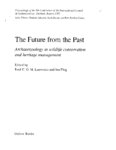 |
Broughton, John | Pristine benchmarks and indigenous conservation? Implications from California zooarchaeology | The superabundance of tame wildlife during the early historic period in California astonished European explorers. And the historic accounts of incredible animal densities, most notably artiodactyls, have influenced a long-held perception that California Indians lived in harmony with nature. However,... | | 2004-01-01 |
| 85 |
 |
Rogers, Alan R. | Quantitative genetics of sexual dimorphism in human body size | A classical data set is used to predict the effect of selection on sexual dimorphism and on the population means of three characters--stature, span, and cubit--in humans. Given selection of equal intensity, the population means of stature and of cubit should respond more than 60 times as fast as d... | Societies; Selection; Species | 1992 |
| 86 |
 |
O'Rourke, Dennis H. | Refutation of the general single locus model for the etiology of schizophrenia | All published studies on the familial incidence of schizophrenia appropriate for testing the applicability of the general single-locus two-allele model are examined under the assumption of a unitary etiology for all schizophrenia. We show that the single major locus model is inadequate to predict th... | Genetics; Diseases in Twins; Chromosome Mapping | 1982 |
| 87 |
 |
McCullough, John M. | Relatedness and kin-structured migration in a founding population: Plymouth colony, 1620-1633 | To test the common assumption of no genetic relationship in a founding population, we calculated average relatedness (r) for the emigrants to Plymouth Colony from Europe on seven voyages from 1620 to 1633. Of 355 individuals, 255 could be individually identified and 4 generations of genealogic depth... | | 1991 |
| 88 |
 |
Broughton, John | Resource intensification and late Holocene human impacts on Pacific coast bird populations: evidence from the Emeryville shellmound avifauna | Anthropologists and conservation biologists have commonly assumed that the distributions and abundances of vertebrate resources recorded during the early historic period in North America reflected a "pristine" condition. This view follows from the perception that Native American population densities... | Resource intensification; Holocene human impacts; Foraging efficiency; Harvest pressure; Bird populations; Emeryville shellmound | 2001 |
| 89 |
 |
Cashdan, Elizabeth A. | Sex differences in aggression: what does evolutionary theory predict? | The target article claims that evolutionary theory predicts the emergence of sex differences in aggression in early childhood, and that there will be no sex difference in anger. It also finds an absence of sex differences in spousal abuse in Western societies. All three are puzzling from an evolutio... | | 2009-08 |
| 90 |
 |
McElreath, Richard | Shared norms and the evolution of ethnic markers | Unlike other primates, human populations are often divided into ethnic groups that have self-ascribed membership and are marked by seemingly arbitrary traits such as distinctive styles of dress or speech (Barth 1969, 1981). The modern understanding that ethnic identities are flexible and ethnic bou... | Ethnic groups; Ethnic identity; Migration; Markers | 2003-02 |
| 91 |
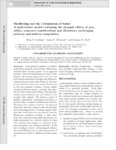 |
Codding, Brian | Shellfishing and the colonization of sahul: a multivariate model evaluating the dynamic effects of prey utility, transport considerations and life-history on foraging patterns and midden composition | Archaeological evidence of shellfish exploitation along the coast of Sahul (Pleistocene Australia-New Guinea) points to an apparent paradox. While the continental record as a whole suggests that human populations were very low from initial colonization through early Holocene, coastal and peri-c... | | 2014-01-01 |
| 92 |
 |
Broughton, John | Size of the bursa of fabricius in relation to gonad size and age in laysan and black-footed albatrosses | Age determination can be difficult for birds that undergo little or no plumage change during life. This is the case for Laysan and Black-footed Albatrosses (Diomedea immutabilis and D. nigripes). The juvenile plumage for both these North Pacific albatrosses is completely grown by about five to six m... | Birds; Species; Development | 1994 |
| 93 |
 |
McElreath, Richard | Social learning and the maintenance of cultural variation: an evolutionary model and data from East Africa | Human societies maintain between-group variation despite mixing of people and ideas. In order for variation to remain, migrants or their children must preferentially adopt local norms, customs, and beliefs. Yet the details of how cultural variation is maintained, despite mixing, remain unknown. This... | Cultural variation; cultural identity; East Africa | 2004 |
| 94 |
 |
Rogers, Alan R. | Sociobiology of sex and sexes (comment) | A comment on "Sociobiology of sex and sexes" by Marion Blute. | Sociobiology; Sex and sexes | 1984-04 |
| 95 |
 |
Codding, Brian F. | Socioecological dynamics structuring the spread of farming in the North American Basin-Plateau Region | The spread of agriculture is a major driver of social and environmental change throughout 25 the Holocene, yet experimental and ethnographic data indicate that farming is less profitable than foraging, so why would individuals choose to adopt agriculture leading to its expansion? Ideal distribution ... | Ideal free distribution model; population ecology; behavioral ecology; maize agriculture; Ancestral Puebloan; Fremont Complex | 2021 |
| 96 |
 |
Hawkes, Kristen | Some current ideas about the evolution of the human life history | Human life history is characterised by a long juvenile period (weaning to reproductive maturity), and a long post-reproductive lifespan in females. How do we explain the differences between our nearest relatives, the great apes, and ourselves? This chapter summarises some recent attempts to use l... | Human life history; Fertility; Apes; Juvenile period | 1999 |
| 97 |
 |
O'Rourke, Dennis H. | South from Alaska: a pilot aDNA study of genetic history on the Alaska Peninsula and the Eastern Aleutians | Abstract The Aleutian Islands were colonized, perhaps several times, from the Alaskan mainland. Earlier work documented transitions in the relative frequencies of mtDNA haplogroups over time, but little is known about potential source populations for prehistoric Aleut migrants. As part of a pilot i... | | 2010 |
| 98 |
 |
O'Rourke, Dennis H. | Spatial and temporal stability of mtDNA haplogroup frequencies in native North America | Mitochondrial DNA lineage frequencies in prehistoric Aleut, eastern Utah Fremont, Southwestern Anasazi, Pyramid Lake, and Stillwater Marsh skeletal samples from northwest Nevada and the Oneota of western Illinois are compared with those in 41 contemporary aboriginal populations of North America. T... | Mitochondrial DNA; Lineage variation; Haplogroup assignment | 2000 |
| 99 |
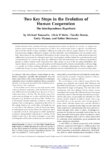 |
Hawkes, Kristen | Stag hunts or rearing environments? | Tomasello et al. have made the case that shared intentionality distinguishes humans from our nearest living relatives. What accounts for the difference? The answer they offer is Stag Hunt choices faced by ancestral foragers. Noting problems with that answer, I urge attention to a promising alternati... | | 2012-01-01 |
| 100 |
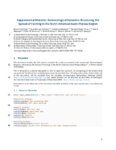 |
Codding, Brian F. | Supplementary Materials: Socioecological dynamics structuring the spread of farming in the North American Basin-Plateau Region | This document includes the code used to complete the analysis presented in the manuscript "Socioecological Dynamics Structuring the Spread of Farming in the North American Basin-Plateau Region" in Environmental 15 Archaeology. | environmental archaeology | |

























